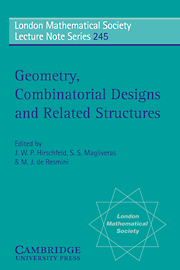Book contents
- Frontmatter
- Contents
- Preface
- Introduction
- On maximum size anti-Pasch sets of triples
- Some simple 7–designs
- Inscribed bundles, Veronese surfaces and caps
- Embedding partial geometries in Steiner designs
- Finite geometry after Aschbacher's Theorem: PGL(n, q) from a Kleinian viewpoint
- The Hermitian function field arising from a cyclic arc in a Galois plane
- Intercalates everywhere
- Difference sets: an update
- Computational results for the known biplanes of order 9
- A survey of small embeddings for partial cycle systems
- Rosa triple systems
- Searching for spreads and packings
- A note on Buekenhout-Metz unitals
- Elation generalized quadrangles of order (q2, q)
- Uniform parallelisms of PG(3, 3)
- Double-fives and partial spreads in PG(5, 2)
- Rank three geometries with simplicial residues
- Generalized quadrangles and the Axiom of Veblen
- Talks
- Participants
Rank three geometries with simplicial residues
Published online by Cambridge University Press: 04 November 2009
- Frontmatter
- Contents
- Preface
- Introduction
- On maximum size anti-Pasch sets of triples
- Some simple 7–designs
- Inscribed bundles, Veronese surfaces and caps
- Embedding partial geometries in Steiner designs
- Finite geometry after Aschbacher's Theorem: PGL(n, q) from a Kleinian viewpoint
- The Hermitian function field arising from a cyclic arc in a Galois plane
- Intercalates everywhere
- Difference sets: an update
- Computational results for the known biplanes of order 9
- A survey of small embeddings for partial cycle systems
- Rosa triple systems
- Searching for spreads and packings
- A note on Buekenhout-Metz unitals
- Elation generalized quadrangles of order (q2, q)
- Uniform parallelisms of PG(3, 3)
- Double-fives and partial spreads in PG(5, 2)
- Rank three geometries with simplicial residues
- Generalized quadrangles and the Axiom of Veblen
- Talks
- Participants
Summary
Abstract
This is a survey of all known rank three geometries belonging to a string diagram of type (c*, c)-geometry. There are three types of objects: points, lines, and blocks subject to axioms imposed by the diagram. There are several other formulations described here which are more convenient for presenting certain of the examples. All examples fall into these six classes:
Simplicial type, which can easily be characterized.
Fischer spaces with no affine planes.
Orthogonal types, whose points and lines are exterior points and tangent lines of certain low-dimensional quadrics.
Hall type, determined by alternating multilinear forms over the field of two elements.
Affine type, whose points are vectors in some d-dimensional space over the integers mod 2. Here, blocks are not subspaces.
A few special examples determined by coherent pairs: the construction of odd type of Cameron and Fisher, and two examples of Blokhuis and Brouwer.
- Type
- Chapter
- Information
- Geometry, Combinatorial Designs and Related Structures , pp. 217 - 240Publisher: Cambridge University PressPrint publication year: 1997
- 3
- Cited by

